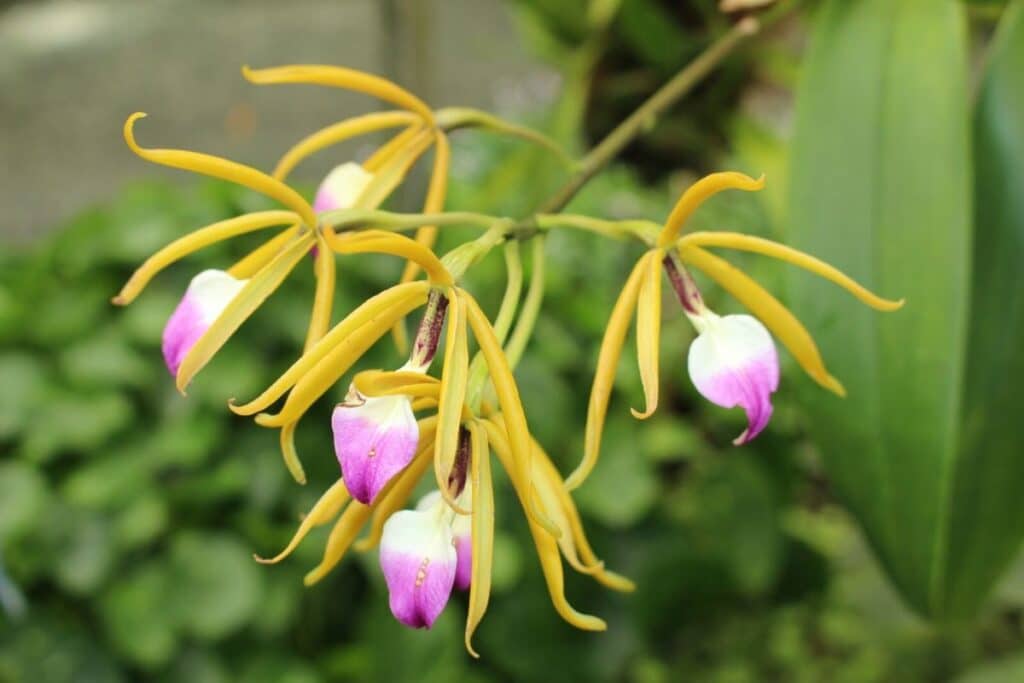Encyclia orchids, otherwise known as butterfly orchids or cockleshell orchids, are known best for their unique and striking flowers that bloom in succession on a long inflorescence.
Here we’ll take you through all you need to know about Encyclia orchids, including facts, history and origins, popular species, and tips on how to grow.
Read on below for our complete Encyclia orchids guide. Enjoy!
Facts About Encyclia Orchids
Encyclia orchids are also known as cockleshell orchids, butterfly orchids, and upside-down orchids.
They are sympodial epiphyte and lithophyte orchids commonly found in lowland forests of Mexico, the Caribbean, Florida, and other parts of tropical Americas. Most species are epiphytic and found growing on branches or trunks of trees.
General Plant Description
Orchids in the Encyclia genus offer an assortment of size, depending on the type species. Regardless, they all have a lip that is not entirely fused to the column but more or less encircles it.
The name Encyclia, in fact, originated from the Greek word enkyklein, which refers to the flower’s lip enfolding the column. The lip of Encyclia flowers almost always displays a different color than the rest of the flower. It can either be ruffled or flat and broad, depending on the species.
Some species have large and showy blooms, while others showcase smaller and more discreet flowers. They flaunt a wide selection of colors, usually ranging from yellow to brown, pink, purple, and green. Most of them produce fragrant flowers.
Encyclia vs. Epidendrum
Encyclia were initially part of the Epidendrum genus. But in 1828, English botanist William Jackson Hooker separated it into a new genus of over 120 known species. Hooker was also the one who named Encyclia viridiflora the type species.
One feature that differentiates one from the other is the flower’s lip. In Epidendrum flowers, the lip and column are fused almost entirely. However, in Encyclia flowers, the lip is fused only near the column’s base (1).
Another distinct difference between the two orchid types is the stem. Epidendrums usually have slender and reed-like stems or sometimes forming pseudobulbs, but Encyclia orchids almost always have ovoid or flattened pseudobulbs (1).
The columns of both orchids are also distinguishable from one another. The clinandrium (part of the tip of the flower’s column) of Epidendrums are typically finely toothed, while that of Encyclias is always three-lobed. Likewise, the rostellum (the projecting part of the column) of Epidendrums is thin, while that of Encyclias is thick (1).
The Subgenera of Encyclia Orchids
The Encyclia genus is further grouped into three sub-genera, such as Osmophytum, Dinema, and Encyclia (1). The sub-genus Dinema only includes one species, which is the Encyclia polybulbon (2).
Popular Encyclia Orchid Species
Encyclia tampensis
Common Names: Florida Butterfly Orchid, Butterfly Orchid, Upside-Down Orchid
One of the most beautiful species of Encyclia is the Florida Butterfly Orchid or E. tampensis, a typical wild orchid in Florida (3). It is native to South Florida, Cuba, and the Bahamas (4).
A hybrid-favorite orchid, Florida Butterfly Orchid showcases fascinating, large blooms that measure up to 1.5 inches in diameter. The fragrant flower is yellow-green with a distinct whitish lip and rose-purple stripe detail on petals and lips.
The leaves are green, leathery, and measure up to 15 inches in length. E. tampensis commence flowering in spring and summer, producing up to 45 fragrant flowers at the same time.
Encyclia alata
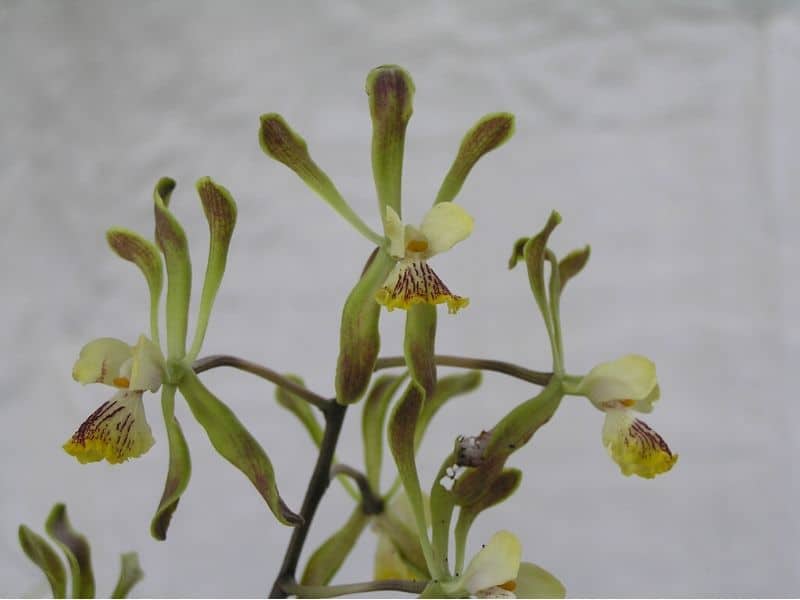
Common Name: Winged Encyclia
The Winged Encyclia (E. alata) is a medium- to large-sized orchid species that can be found through Mexico to Costa Rica.
The greenish-yellow and brown flowers of this Encyclia orchid species measure about 2 to 2.5 inches in diameter and feature a honey-sweet fragrance. They bloom from May to August along an arching and branched inflorescence of up to 6 ft long (5).
Encyclia cochleata

Common Names: Clamshell Orchid, Octopus Orchid, Squid-Type Encyclia Orchid
Encyclia cochleata orchids, otherwise known as the Clamshell Orchid, Octopus Orchid, or Squid-type Encyclia Orchids, are autumn- to spring-blooming orchids that originated from Mexico to Venezuela and Cuba (5).
The flowers resemble an octopus, hence the common name. They have narrow petals and sepals that droop down over the ovary and pedicel, whereas the lips are shell-shaped and mostly green with purple and black stripes (5).
One of the best features of this Encyclia orchids is that it continues to bloom for six months, occasionally until the new growth matures and commences flowering (5).
Encyclia bractescens
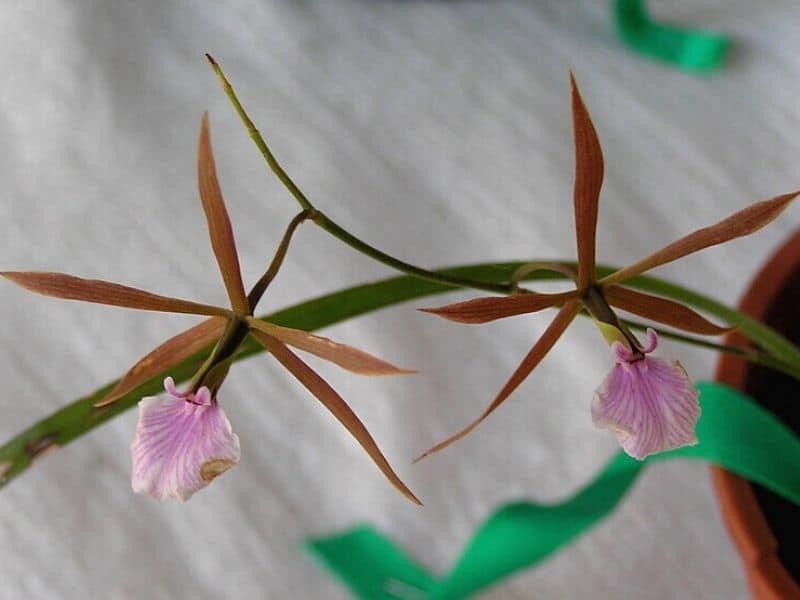
Common Name: Bractescent Encyclia Orchid
E. bractescens or the Bractescent Encyclia are small epiphyte orchids commonly found in Mexico, Honduras, El Salvador, Belize, and Guatemala at elevations around 1200 meters.
Clusters of two to twelve flowers typically bloom during late winter to early spring from a lightly branched inflorescence of this mini type Encyclia orchid. The inflorescence grows about 15 inches in height.
Individual flowers are fragrant, long-lived, and measure approximately 2.5 cm in diameter. Moreover, this Encyclia species features tightly clustered pseudobulbs and two shiny, tongue-shaped leaves.
Encyclia radiata
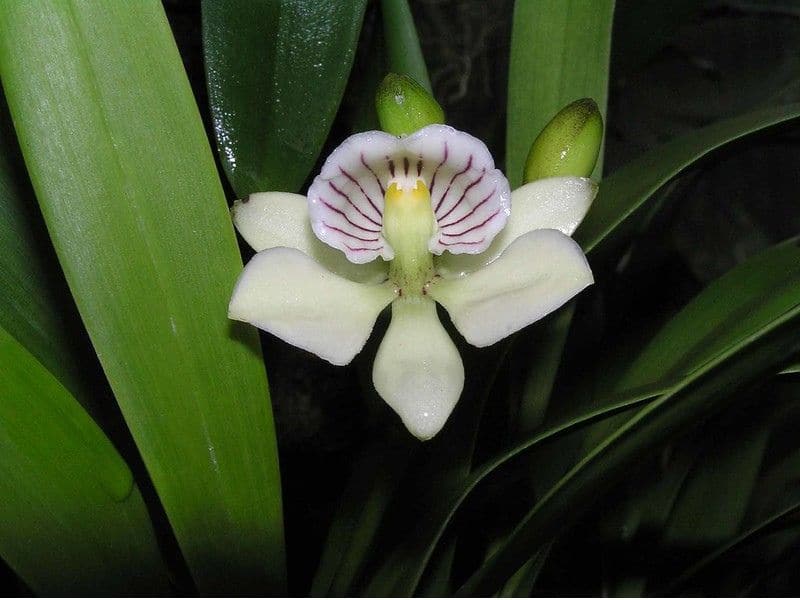
Common Name: Lined Petal Orchid
The Lined Petal Orchids (E. radiata) are native to Mexico. They are popular for their small (4 cm) and highly fragrant creamy white flowers with a white lip that is covered with purple streaks.
Each inflorescence (10 cm in length) boasts more or less 15 of these sweetly fragrant flowers. This orchid’s bloom time varies, but it can flower twice a year with blossoms lasting up to 3 months.
Encyclia cordigera
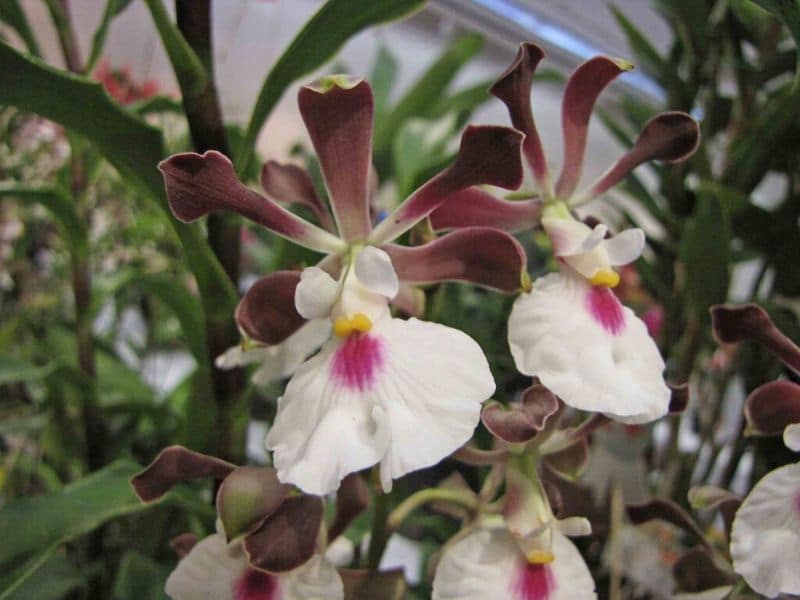
Common Name:
E. cordigera is one of the most well-liked Encyclia orchids that originated from Central and South America. They are best known for their attractive blooms that are not only exceptionally fragrant but also large and showy. Each flower has a broad, flat, and ruffled lip.
The famed intergeneric hybrid Epicattleya Florida is one of the many products of hybridization of this Encyclia species with other members of the Cattleya alliance. It’s also commonly used as a parent within the genus to create hybrids.
Growing Encyclia Orchids
Encyclia orchids are relatively easy to grow indoors if given proper care and cultural practices. As a matter of fact, some species like the E. cochleata have gained popularity as houseplants because of their captivating and highly fragrant flowers. Below you’ll find useful Encyclia care tips when growing this type of orchid plant.
Light
Most species of butterfly orchids or cockleshell orchids thrive best under bright light. Species with delicate leaves prefer half-shade, while Encyclias with thicker leaves perform best under bright, indirect light. Avoid placing the plants where there is too much direct sunlight since that will burn their leaves.
Temperature
Generally, these Central America orchids prefer cool to warm temperatures. Ideal day temperatures should be between 70 degrees F to 85 degrees F (21.1 degrees C to 29.4 degrees C), whereas night temperatures should be somewhere between 55 degrees F to 70 degrees F (12.8 degrees C to 21.1 degrees C).
Some species like warm to hot, but most Encyclia orchids perform best in intermediate temperatures.
Note that exposing an Encyclia plant to extended periods of high temperatures may cause damage, prevent growth, or reduce flowering. On the contrary, a 10 to 15 degrees drop in night temperature will encourage blooming.
Humidity
Keep the humidity at 50% to 80% since Encyclia orchids perform best in fairly humid conditions. If you have to increase the humidity, you can use a humidifier or a humidity tray. You can also mist your plant a few times daily to get high humidity.
Water
Encyclia orchids like a moist environment. Water your Encyclia plants every 5 to 7 days, but allow the roots to dry out between watering. It can be done every other week in colder months.
However, you may have to do it more frequently or at least three times a week during the warmer months. The general rule is to water frequently when the plant is in active growth and less when it is dormant.
You can use clay pots to help regulate the soil’s moisture level. Clay pots are porous, which allows air and moisture to pass through the walls of the pot and into the soil. This helps to prevent overwatering and root rot, which can be a common problem with orchids.
Fertilizer
Use a balanced fertilizer (20-20-20) for Encyclia orchids. Like Epidendrums, these orchids should be fed constantly when in full growth.
Fertilize every seven days with clear waterings in between during spring to fall. Then, reduce to light feeding once a month during fall to winter.
Potting and Growing Media
Most Encyclia orchids grow best mounted on cork or planted in a medium-sized pot. As for the growing media, Encyclia species with thin roots need small to medium bark pieces in the potting mix, whereas species with thick roots require larger bark pieces.
FAQs
What is the medium for Encyclia orchids?
Encyclia orchids thrive in a well-draining orchid mix, commonly composed of materials like bark, sphagnum moss, and perlite. This type of medium provides good aeration and drainage to mimic their natural epiphytic orchids growing conditions.
How long do Encyclia flowers last?
The duration of Encyclia orchid flowers varies by species and growing conditions, but generally, the blooms can last several weeks to a couple of months. Proper care, including suitable light levels, watering, and temperature, can contribute to longer-lasting flowers.
What is the difference between Dendrobium and Cattleya?
Dendrobium and Cattleya are distinct genera of orchids. Dendrobiums often have a flower spike that grows from the top of the pseudobulb and bears flowers along the length of the canes. Cattleyas, in contrast, are known for large, showy flowers with vibrant colors and a distinctive lip. They typically have rounded pseudobulbs and are admired for their beauty and fragrance. The two genera have different growth habits, flower structures, and care requirements.
Final thoughts
Successful Encyclia orchid care involves providing optimal light, well-aerated substrates, and vigilant pest control. By adhering to these practices, enthusiasts can cultivate healthy and vibrant Encyclia orchids, showcasing the beauty of these resilient and captivating flowers.
*Photo by RukiMedia/depositphotos
References
Reference List
- Dressler, Robert & Pollard, Glenn. (1974). The Genus Encyclia in Mexico. Mexico, Asociacion Mexicana de: Orquideologia. 24. 10.2307/1219019.
- Dressler, R., n.d. Field Guide To The Orchids Of Costa Rica And Panama.
- Atlas of Florida Plants. 2020. Encyclia Tampensis – Species Details. [online] Available at: <https://florida.plantatlas.usf.edu/plant.aspx?id=2477>
- Encyclia tampensis (Butterfly orchid, Florida Butterfly Orchid, Scarlet Orchid, Tampa Butterfly Orchid) | North Carolina Extension Gardener Plant Toolbox (2020). Available at: https://plants.ces.ncsu.edu/plants/encyclia-tampensis/
- Complete Guide to Orchids (2020). Available at: https://books.google.com.ph/books?id=t25cHQ-UK4YC&pg=PA138&lpg=PA138&dq=Encyclia+alata+.edu&source=bl&ots=28Y-bA7je2&sig=ACfU3U34GtHOvNz3hBjRLy8LMmbMhI1OYg&hl=en&sa=X&ved=2ahUKEwjonbWrwf7pAhWl-GEKHX-WC3sQ6AEwFHoECAkQAQ#v=onepage&q=Encyclia%20alata%20.edu&f=false
Close

